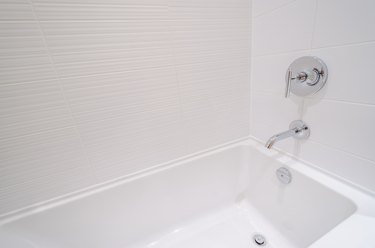
In This Article
A tub diverter valve allows you to fill your bathtub with water one minute and switch to a shower the next. This simple mechanism allows small bathrooms to remain completely functional without the need to have separate bathtub and shower stations. Tub diverter valves come in three different designs: lift gate, push button or cartridge.
Tip
A tub diverter works by creating a pressurized environment within the shower valve, which forces water to travel against gravity and exit the showerhead.
Video of the Day
Rod/Lift Gate Tub Diverters
A popular type of tub diverter valve called a lift gate diverter sits directly inside the tub spout. A sturdy piece of plastic slides into grooves inside the mouth of the spout. A metal rod enters the tub spout from the top and clips on to the plastic gate.
Video of the Day
When the rod is pushed down, the gate lies below the water supply pipe, allowing water to flow freely from the tub spout. When the rod is pulled up, the gate lifts and covers the flow of water. Water pressure quickly builds up inside the pipe and diverts water to the only other place it can go: through the pipe leading up to the showerhead.
To ensure the gate stays firmly in position and to prevent water from leaking out of the tub spout (which can result in low water pressure in the showerhead), the gate also has a rubber gasket on one side. The gasket creates a seal between the water supply pipe and the plastic gate. If the rod does not stay in the "up" position or water begins to leak from the tub spout, replace the rubber gasket.
Some showers feature a push button diverter located under the faucet handle. This type of diverter includes three main components: a metal rod, a spring and a rubber gasket.
When you press the metal rod, the spring engages and the rubber gasket rests on the back wall of the shower valve or pipe junction. In this position, it's completely out of the way and water follows the law of gravity, flowing down and out of the tub spout. When the metal rod is pressed again, the spring releases and the rubber gasket seals the pipe leading to the tub spout. Pressure will build and force the water upward until it comes out of the showerhead.
The exact design of the rubber gasket in a push button diverter depends on the design of the shower valve, so it's important to choose the correct replacement. Some gaskets look like paddles and lay horizontally to cover the tub pipe. Other diverters are designed to allow the tub water to flow through a hollow tube in the diverter and down into the tub pipe, so these diverters have vertically positioned gaskets.
Cartridge Diverter Valves
Finally, some diverters are controlled through a handle. This handle may exist separately from the other shower faucet handles or it can be integrated into the handle. The diverter engages when the handle is turned or pulled.
These handles are connected to a cartridge that looks and functions just like the cartridges in the hot and cold faucets, which consist of a cylinder with a rubber gasket on the end. They operate similarly to push-button diverters, but the gasket is compressed using a threaded handle versus a spring-loaded mechanism.
When the diverter handle is turned in one direction, the cylinder is lifted away from the water pipes, which creates zero water pressure and sends the water down to the tub spout. When the diverter handle is turned in the opposite direction, the gasket tightens over the pipe leading to the tub spout. Now, the water must travel upward and exit the showerhead.